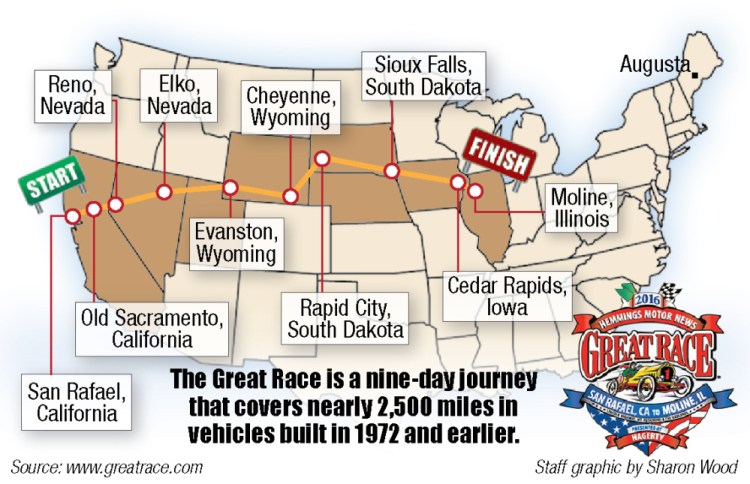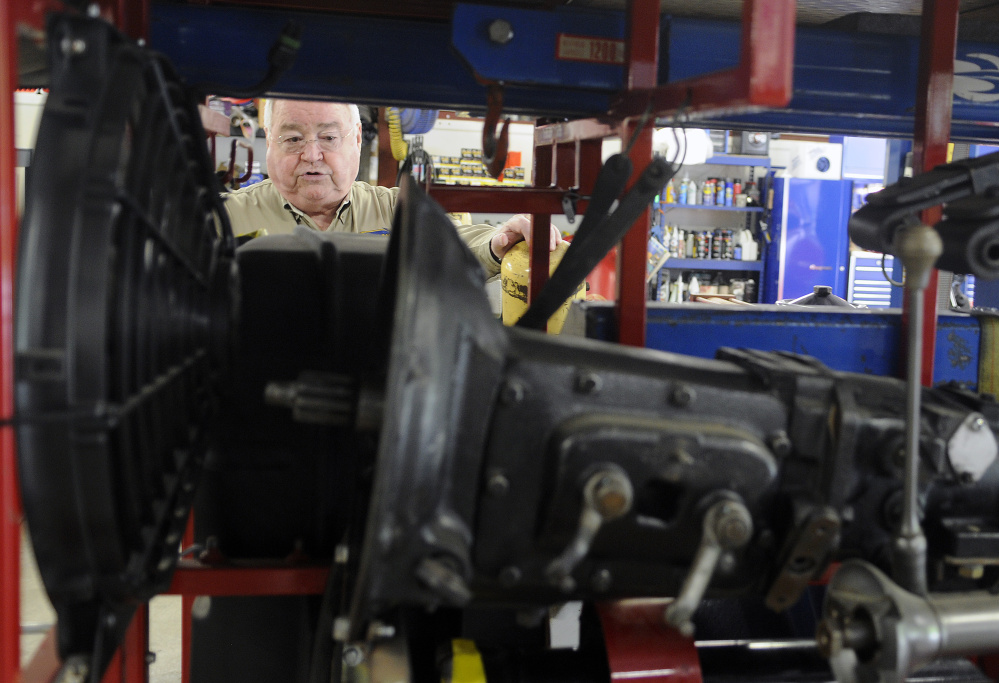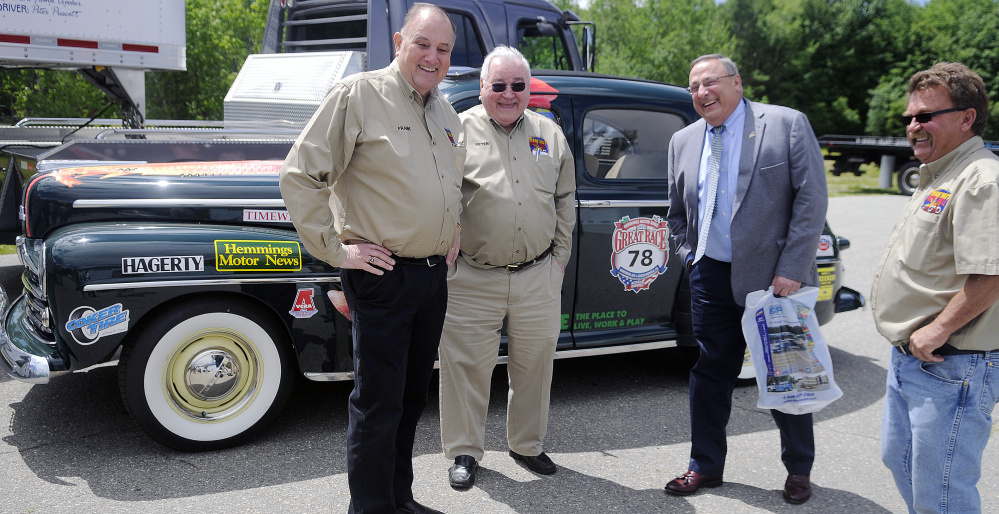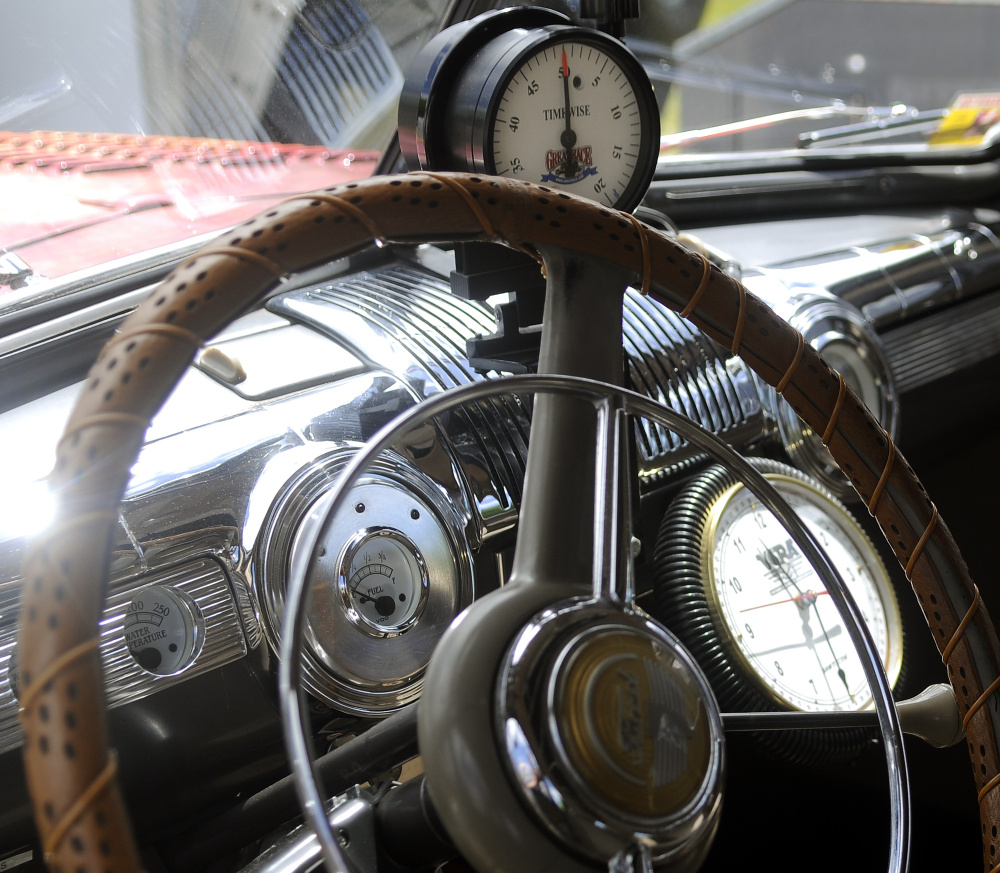GARDINER — If it weren’t for the car parts and harsh overhead lights, Peter Prescott could have been presiding over an executive meeting at the E.J. Prescott’s headquarters a few miles away.
But the business of the day was not waterworks or storm-water solutions. It was how to transport Prescott’s 1948 Ford sedan from Maine to San Rafael, California, and how to drive it 2,400 miles from there to Moline, Illinois, in the 2016 Hemmings Motor News Great Race.
The Great Race is a different kind of race. It’s an antique, vintage and collector car controlled-speed endurance rally that takes place on public highways. That means that competitors follow a specific course using only provided maps and materials, and they have to do it in a specified time. It’s nine days long, and this year the grand champion of the event will win $50,000 from a prize purse that totals $150,000. More than 135 teams have signed up.
“It really should be on everybody’s bucket list,” Prescott said.
And if the chief executive officer of the Gardiner-based E.J. Prescott Inc. has his way, the annual race could kick off in Maine and travel through the state sometime in the near future, maybe even in a couple of years.
The 2014 race started in Ogunquit, he said, but the course took competitors directly south from there to the Villages, a retirement community west of Daytona Beach, in Florida, where throngs of crowds greeted the exhausted driving teams.
ON YOUR MARK
Prescott first learned about the race about 20 years ago.
He was at an auto auction in Arizona and came across a booth promoting the event, and it lit his imagination.
Organizers launched the Great Race in 1983 with two competitors. In succeeding years, the event drew more and more drivers. But Prescott never followed up, and for a period of time the race halted operations. In 2011, new organizers revived the race. Three years later, it came knocking on Maine’s door; and when it did, Prescott finally answered.
Long a fan of vintage cars and owner of PEP Classic Car Co., he put together the Maine Boyz and headed south. His was the only Maine car to take part, but it was a good run and a strong finish. The Maine Boyz car came in sixth in the rookie class that year and 47th overall.
Prescott was hooked.
This year’s Maine Boyz team has five members. Ed Chapman and Frank Crooker are drivers, Guy McDorr is the navigator, John Myrick will drive the transport truck, and the crew chief is Frank Landry. Prescott is also listed as a driver, but a bad back will keep him home this year. McDorr is a new and experienced addition to the team, with about 15 rallies behind him.
The field consists of cars ranging from a 1916 Hudson Pikes Peak Hillclimber to a 1972 Jensen Healey. The field will be filled with Indy Racers, Mercedes, BMWs, Plymouths, Volkswagens, Jaguars and even a 1953 Chevrolet firetruck. Teams come from all over the country to take part. This year, a number have come from Japan.
Prescott’s car, No. 78, will be distinguished by the red lobster that decorates the hood, roof, trunk and doors and contrasts nicely with the car’s original dark green paint. It’s part of his plan to highlight Maine, and the team has goody bags to share along the way, filled with Maine swag.
GET SET
Preparing for the rally is an event of its own.
The team members have mapped out a practice course, and they have been running it for two months.
The car has been put through a comprehensive checkup. On Thursday, conferring with Prescott, Thomas Pearl, who can fix just about anything, pointed out a small piece of metal missing from the front spring that he changed out. It probably would not have been a problem, but the route will not be forgiving of mechanical faults.
The slightly damaged spring will go on the rack that is carrying duplicates of every mechanical piece of No. 78 for the trip — engine, transmission, radiator, battery, hoses, clamps and fluids. Damaged though it is, it’s insurance. Under the rules of the race, anything that is broken can be replaced, even if it takes all night for the crew to do. No one wants a “DNF” — a did not finish.
The rule booklet for the 2016 race is 31 pages long and covers every aspect of the race with great specificity, including what equipment is allowed.
Here’s the rule about the vehicle clock:
“One mechanical or quartz-crystal watch or clock. This is the primary timepiece and is the responsibility of the contestant. The watch/clock may have (one each) analog hour, minute, and second hand. The clock must not have a stopwatch, compensating, calculating or split-action functions or digital readout. The clock must not be electrically connected to the vehicle (i.e., it must have its own internal battery rather than using the vehicle’s). A clock with forbidden functions (such as stopwatch, split-action, etc.) that has been modified to disable those functions is not allowed. Temporary marks are allowed on the glass face. The maximum clock dimension (height, width, diameter, etc.,) is 10 inches, measured on the face of the clock.”
The watches the driver and navigator are allowed to wear (analog only) and the kind of stopwatch permitted are covered under similarly exacting standards.
Teams can’t use GPS or maps other than what’s provided, and there are limits to the equipment cars may carry.
The rules also outline the list of the many infractions that can result in penalties assessed on times or, if serious enough, can disqualify competitors.
“You aren’t supposed to speed,” Prescott said. Because it’s a timed event, there’s no benefit for reaching a checkpoint early. But you don’t want to be late, either, because that affects your standings.
“They try to trick you on the instructions,” he said. In his first year, drivers were directed at one point to turn right at the first paved road. When they reached a decision point, it wasn’t clear whether that was the road intended or someone’s driveway. It ended up being a driveway that ended over the crest of hill.
“We get there and we turned. We almost rolled over,” he said. To make up time, Prescott floored it. The car would have to stop to make the corner to get back on the route, but that would mean slowing down.
“You can’t stop when you’re that far behind!” he said, laughing. He yanked the steering wheel right and took the corner on two wheels before the Ford dropped back onto four wheels and they were back on the route, making up for lost time.
GO
The truck carrying No. 78 leaves Gardiner on Saturday morning.
The Ford and its transport bear the autographs of Gov. Paul LePage, who stopped by to wish the team well.
The Maine Boyz anticipates reaching California in about four days, in time for registration and the pre-race inspections and preparations and calibration of the speedometers.
The rally kicks off June 13 on the same streets where the movie “American Graffiti” was filmed. The coming-of-age movie highlighted both cruising and rock ‘n’ roll cultures in the early 1960s. The route crosses deserts in Nevada and Utah, goes over the Rocky Mountains in Wyoming and traverses the Badlands of South Dakota before crossing Iowa into the relatively flat terrain of Illinois.
Because of the range in ages and capabilities of the cars, the route follows state highways, and the staggered start times keep competitors spaced out enough to prevent traffic jams.
The rally has scheduled stops in towns along the way, where organizations provide lunch for participants. Everyone stays in the same city or town overnight, filling up hotel rooms and restaurants for breakfast and dinner for drivers and support teams. And in some places, time is set aside to take in the local sights.
That’s what Prescott wants for his home state, and he hopes to persuade race organizers to give Maine a longer look.
Next year’s race will run from Florida to Michigan, but the route of the 2018 race has not been announced yet.
All of that is in the future. Starting next week, Prescott will be tracking his team’s progress from home.
And in reflecting on his Great Race experiences, he said he’s really made only one big mistake. “Paying to go the first time.”
Jessica Lowell — 621-5632
Twitter: @JLowellKJ
Copy the Story LinkSend questions/comments to the editors.






Success. Please wait for the page to reload. If the page does not reload within 5 seconds, please refresh the page.
Enter your email and password to access comments.
Hi, to comment on stories you must . This profile is in addition to your subscription and website login.
Already have a commenting profile? .
Invalid username/password.
Please check your email to confirm and complete your registration.
Only subscribers are eligible to post comments. Please subscribe or login first for digital access. Here’s why.
Use the form below to reset your password. When you've submitted your account email, we will send an email with a reset code.